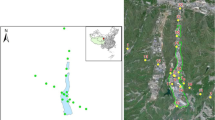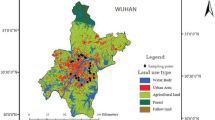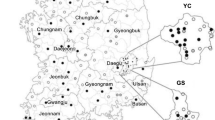Abstract
Surface soil samples were collected in two karst Tiankengs, Dashiwei and Datuo, situated within the Dashiwei Tiankeng group, located in Leye County of Guangxi province, South China. The soil samples were analyzed for 23 kinds of organochlorine pesticides (OCPs) using a gas chromatography electron capture detector device. The results showed that the concentrations of OCPs in soils of Dashiwei Tiankeng ranged from 0.03 to 5.13 ng/g for total OCPs, not detectable (ND) to 0.22 ng/g for Hexachlorocyclohexane (HCHs), and 0.01 to 3.61 ng/g for Dichlorodiphenyltrichloroethane and metabolites (DDTs). Concentration of the total OCPs in soils of Datuo Tiankeng ranged from 0.13 to 14.36 ng/g, ND to 0.39 ng/g for HCHs, and 0.01 to 3.28 ng/g for DDTs. These concentrations indicated that there could be new inputs of HCHs and DDTs from recent application of lindane and dicofol in this area. Further analysis also revealed that the concentration of OCPs at the bottom of both Tiankengs was higher than the top. The variability in concentrations between the top and the bottom was attributed to the “cold trapping effect” for persistent organic pollutants (POPs) in karst Tiankeng topography. The difference in temperature between the top and bottom of Tiankeng is a predominating factor which can cause a POPs “cold trapping effect.” Other environmental factors are proposed to explain the difference in concentration such as humidity, topography (or slope), wind speed, wind direction, solar radiation, vegetation cover, and soil organic matter. The environmental condition of Dashiwei Tiankeng appears to favor the accumulation of OCPs than that of Datuo Tiankeng because Dashiwei Tiankeng is a matured Tiankeng but Datuo Tiankeng is a degraded one. Thus, there is the need for further studies on the environmental factors influencing distribution of OCPs in karst Tiankeng.





Similar content being viewed by others
References
Borghini F, Grimalt JO, Juan CSH, Barra R, Torres GCJ, Focardi S (2005) Organochlorine compounds in soils and sediments of the mountain Andean Lakes. Environ Pollut 136:253–266
Chen DY, Huang WL (2003) Sorption mechanism of hydrophobic organic contaminants by soil organic matter fractions. Geochimica 32(4):363–367
Daly GL, Wania F (2005) Organic contaminants in mountains. Environ Sci Technol 39(2):385–398
Fu S, Chu S, Xu X (2001) Organochlorine pesticide residue in soils from Tibet, China. Bull Environ Contam Toxicol 66:171–177
Gouin T, Mackay D, Jones KC, Harner T, Meijer SN (2004) Evidence for the ‘‘grasshopper’’ effect and fractionation during long range atmospheric transport of organic contaminants. Environ Pollut 128:139–148
Grimalt JO, Van Drooge BL, Ribes A, Vilanova RM, Fernandez P, Appleby P (2005) Persistent organochlorine compounds in soils and sediments of European high altitude mountain lakes. Chem 54:1549–1561
Hung H, Blanchard P, Halsall CJ et al (2005) Temporal and spatial variabilities of atmospheric polychlorinated biphenyls (PCBs), organochlorine (OC) pesticides and polycyclic aromatic hydrocarbons (PAHs) in the Canadian Arctic: results from a decade of monitoring. Sci Tot Environ 342:119–144
Kim SK, Oh JR, Shim WJ et al (2002) Geographical distribution and accumulation features of organochlorine residues in bivalves from coastal areas of South Korea. Mari Pollut Bull 45:268–279
Lambert SM (1967) Functional relationship between sorption in soil and chemical structure. J Agric Food Chem 15:572–576
Li YF, Macdonald RW (2005) Sources and pathways of selected organochlorine pesticides to the Arctic and the effect of pathway divergence on HCH trends in biota: a review. Sci Tot Environ 342:87–106
Liu WJ, Xie WM, Chen DZ, Zheng XY, Liu XD, Zhu XH, Yang YL (2007) The source analysis for organochlorine pesticides in Wolong natural reserve soil. Res Environ Sci 20(6):81–86
Martins CC, Bicego MC, Rose NL et al (2010) Historical record of polycyclic aromatic hydrocarbons (PAHs) and spheroidal carbonaceous particles (SCPs) in marine sediment cores from Admiralty Bay, King George Island, Antarctica. Environ Pollut 158:192–200
Negoita TG, Covaci A, Gheorghe A (2003) Distribution of polychlorinated biphenyls (PCBs) and organochlorine pesticides in soils from the East Antarctic coast. J Environ Monit 5(2):281–286
Oramah IT (2008) Polynuclear aromatic hydrocarbons in Dashiwei Karst Tiankeng (sinkholes), South China. Environ Geosci 15(2):75–83
Oramah IT, Qi SH, Kong XS et al (2008) Distribution of polycyclic aromatic hydrocarbons in Datou karst Tiankeng of South China. Environ Geochem Health 30:423–429
Singh RP (2001) Comparison of organochlorine pesticide levels in soil and groundwater of Agra, India. Bull Environ Contam Toxic 67:126–132
Waller K, Vallero DA, Lewis RG (1999) Factor influencing the distribution of lindane and other hexachlorocyclohexane in the environment. Environ Sci Technol 33(24):4373–4378
Wang XP, Xu BQ, Kang SC, Cong ZY, Yao TD (2008) The historical residue trends of DDT, hexachlorocyclohexanes and polycyclic aromatic hydrocarbons in an ice core from Mt. Everest, central Himalayas, China. Atmos Environ 42:6669–6709
Wania F, Mackay D (1996) Tracking the distribution of persistent organic pollutants-control strategies for these contaminants will require a better understanding of how they around the globe. Environ Sci Technol 30:390A–396A
Willett KL, Ulrich EM, Hites SA (1998) Differential toxity and environmental fates of hexachlorocyclohexane isomers. Environ Sci Technol 32:2197–2207
Xing XL, Qi SH, Zhang K, Zhang Y, Kan ZZ, Qin B (2009) Influence of landform and season on distribution characteristics of organochlorine pestcides (OCPs)—a case in Chengdu economic region, Sichuan province, China. Res Environ Yangtze Bas 18(10):985–991
Yang QS, Mai BX, Fu JM, Sheng GY, Wang JX (2004) Spatial and temporal distribution of organochlorine pesticides (OCPs) in surface water from the Pearl River artery estuary. Environ Sci 25(2):150–156
Yang GY, Wan K, Zhang TB, Luo W, Gao YX, Wan HF (2008) Residues and distribution character of HCHs and DDTs in agricultural soils from the typical areas of Guangdong province. Res Environ Sci 21(1):113–117
Yeo HG, Choi MY, Chun MY, Chun MY, Sunwoo Y (2003) Concentration distribution of polychlorinated biphenyls and organochlorine pesticides and their relationship with temperature in rural air of Korea. Atmos Environ 37(27):3831–3839
Yu G, Niu JF, Huang J et al (2005) Persistent organic pollutants—environmental problem of new globality. Science Press, Beijing
Yuan DX, Cai GH (1988) The science of karst environment. Chongqing Press, Chongqing
Zhu XW, Chen WH (2006) Tiankeng in the karst of China. Carsological Sinica 25(Suppl):7–24
Zhu XW, Tony WT (2006) Tiankeng: definition and description. Carsological Sinica 25(Suppl):35–42
Zhu XW, Huang BJ, Zhu DH, Chen WH (2003) Dashiwei Tiankeng group, LeYe, Guangxi, discoveries, exploration, definition and research, 1st edn. Guangxi Science and Technology Press, Guangxi
Acknowledgments
This study was funded by the Institute of Karst Geology, Chinese Academy of Geological Science (No. 2009013), and the National Natural Science Foundation of China (No. 40473043).
Author information
Authors and Affiliations
Corresponding author
Rights and permissions
About this article
Cite this article
Kong, X., Qi, S., It, O. et al. Distribution of organochlorine pesticides in soils of Dashiwei Karst Tiankeng (giant doline) area in South China. Environ Earth Sci 70, 549–558 (2013). https://doi.org/10.1007/s12665-012-2140-y
Received:
Accepted:
Published:
Issue Date:
DOI: https://doi.org/10.1007/s12665-012-2140-y




